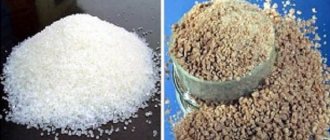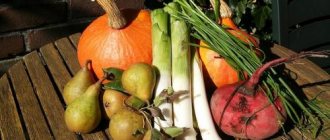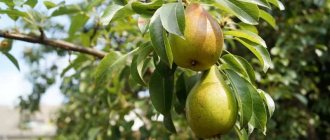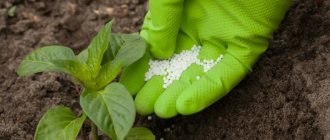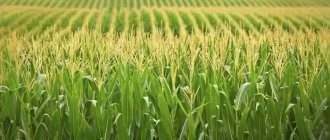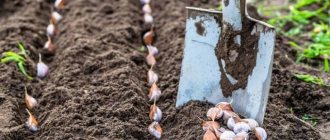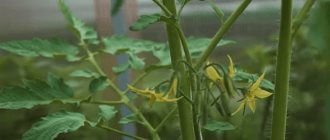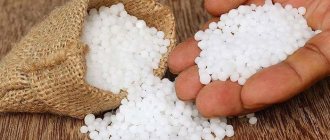The role of phosphorus fertilizers in plant development
Phosphorus controls constant metabolic processes and is part of DNA and RNA. Significantly increases drought and frost resistance of plants. Young, intensively growing seedlings especially need phosphorus.
Phosphorus starvation. It manifests itself in a change in leaf color to purple, bronze and a delay in flowering and ripening.
Deadlines for submission. Phosphorus fertilizers, including water-soluble ones, are not washed out of the soil. They are embedded closer to the roots, applied for digging in the fall or spring: sparingly soluble phosphorus fertilizers (phosphate rock) are applied in the fall, superphosphates - in the spring.
How to determine what plants are missing
A lack of phosphorus in the soil leads to a slowdown in plant growth, the leaves become dark green with a bluish tint, and the stems become lilac and violet. The root system develops poorly, the crop matures later, and disease resistance is seriously reduced.
With phosphorus deficiency, the taste characteristics of potatoes deteriorate. In fruit crops, the shoots are thin and short, growth is poor, the leaves are narrow and small. Flowering weakens, fruits fall off, winter hardiness decreases.
In the early stages, phosphorus is especially needed by carrots and beets, as well as tomatoes. Phosphorus deficiency is poorly tolerated by peaches and apple trees, strawberries and black currants. Adult plants do not immediately show signs of element deficiency, since they use internal reserves for some time.
Popular phosphorus-containing fertilizers
Superphosphate
The most popular phosphorus fertilizer is double superphosphate; it is most often used in the garden. Simple and double superphosphate differ from each other not only in phosphorus concentration: simple superphosphate (16–22%), double (up to 45%). In addition, double superphosphate also contains about 15% nitrogen compounds and 6% sulfur, and, unlike simple superphosphate, it does not contain gypsum. Both are suitable for use in all areas and for any crops: flowers, vegetables, trees.
Bone meal, or phosphonitrogen
Natural fertilizer (contains 15–35% phosphorus) – a product of bone processing. In addition to phosphorus, bone meal contains calcium, biologically active substances and trace elements (magnesium, sodium, iron, copper, zinc, manganese, cobalt, iodine). Serves as a comprehensive fertilizer for vegetables (tomatoes, peppers, cucumbers) and flowers. Indoor crops - palm trees, vines, ficus - respond especially well to bone meal. In its properties, bone meal occupies an intermediate position between superphosphate and phosphate rock. Completely decomposes in the ground in 5–8 months.
Phosphorite flour
Slightly soluble phosphorus fertilizer (phosphorus - no less than 20%, calcium - no less than 34.8%) with a very long-lasting effect when applied in high doses before planting (from 100–200 to 500 g per 1 m2). They are used only for autumn digging on acidic soils or for preparing acidic composts - manure and peat: in an acidic environment, phosphorus gradually transforms into a form accessible to plants. Do not use on soils with neutral and alkaline reactions. Phosphorite flour cannot be mixed with lime fertilizers and ash; it can be mixed with ammonium sulfate, ammonium nitrate, potassium chloride and simple superphosphate.
Making your own phosphorus fertilizer
One of the most famous and accessible fertilizers is compost. It is a waste product of decaying plants, insects, biological waste and various microorganisms.
Making this fertilizer is quite simple. It is enough to comply with certain requirements.
Rule 1. The compost heap must consist of the following components:
- nitrogen mass (chicken droppings, manure, residues from fruits and vegetables, grass, various weeds and thick stems);
- carbonaceous mass (straw, shavings, leaves, parchment, newspaper, cardboard, tree branches, etc.).
These components must be combined in a 1:1 ratio.
Rule 2. To avoid long-term decomposition, all organic elements must be thoroughly crushed.
Basic complex fertilizers with phosphorus
Double nitrogen-phosphorus fertilizers:
Ammophos: a complex water-soluble phosphorus-nitrogen fertilizer (phosphorus - 50%, nitrogen - 12%), where both elements are contained in an easily digestible form. Nitroammophos: nitrogen-phosphorus fertilizer (phosphorus - 11-24% and nitrogen - 16-23%), suitable for use on soils with normal or high potassium content.
Diammophos (ammonium hydrogen phosphate, diammonium phosphate) Phosphorus-nitrogen fertilizer (phosphorus - 46-50%, nitrogen - 18%). Diammophos reduces soil acidity and is used as a pre-sowing fertilizer for most vegetable crops.
Double phosphorus-potassium fertilizers:
potassium phosphate.
Triple complex fertilizers: ammophoska and nitrophoska, magnesium ammonium phosphate.
Azofoska (nitroammofoska) Complex nitrogen-phosphorus-potassium fertilizer (the content of nitrogen, phosphorus and potassium is approximately equal) is one of the most effective mineral fertilizers, where phosphorus is in a water-soluble form. Nitroammofoska can be used as a universal fertilizer on any type of soil. It is used for pre-sowing and planting application, as well as for fertilizing.
Fertilizers containing phosphorus and their use
For the production of phosphorus-containing fertilizers, the main raw materials are phosphate ores, which include phosphorites and apatites. They are cleaned of impurities and ground into the finest powder. Then it is saturated with sulfuric, nitric or phosphoric acid. Next comes the process of phosphate reduction and high-temperature treatment. In this way, several types of agrofertilizers are obtained, which differ in solubility and concentration of macro- and microelements.
Phosphorite
Phosphorus supplements are divided into four main groups.
- Water-soluble fertilizers are most in demand by gardeners and gardeners, as they are easy to use. They are also suitable for all soils without exception, and are used to feed all types of plants. They can be applied in a variety of ways at any time during the season. The main purpose of this type of fertilizer is to strengthen the roots.
- Lemon-soluble or citrate-soluble fertilizers dissolve in low concentration acids. Phosphorus compounds, which are part of this group of agricultural fertilizers, do not dissolve in water. The best results from using fertilizers of this type are achieved on acidic substrates. Recommended for use on depleted soils to increase fertility.
- Hardly soluble fats can only be dissolved in strong acids, such as sulfuric or nitric. The most effective phosphorus fertilizers of this group are for use in the northern regions and non-chernozem zones with leached or degraded soils. The peculiarity of this type of fertilizer is the need to deepen it, since phosphorus does not penetrate to the roots on its own. The main time of application is autumn, which is associated with the duration of the feeding.
- Complex fertilizers include multicomponent mixtures : nitrogen-phosphorus-potassium or phosphorus-potassium. They are universal due to the fact that plants immediately receive all the macroelements necessary for life. They are used both in the spring when planting and in the fall when digging up the soil; the amount of substance applied will vary.
In addition, there is a group of phosphate liquid fertilizers. In addition to phosphorus, their composition may also include sulfur, nitrogen and other elements. This type of fat is supplied for sale in canisters ready for use; storage temperature can reach - 17°C. The phosphorus content in liquid agricultural products is higher; they are used when planting by applying to the hole and as foliar fertilizers.
Liquid phosphorus fertilizer
You can also prepare your own natural phosphorus fertilizers. To do this, use ash, bones or plants containing the element.
The combustion product contains, in addition to phosphorus and potassium, a large number of trace elements. This feeding is beneficial for eggplants, cucumbers, peppers, tomatoes, and potatoes. Fertilizer promotes winter hardiness of fruit and berry bushes and trees.
Bones for feeding are calcined over fire, as a result of which phosphorite, calcium phosphate, remains in them. Grind into powder and sift through a sieve. Large elements are re-crushed. In addition to the necessary macroelements, meat and bone meal includes microelements such as iodine, iron, manganese, copper, zinc, and cobalt. Suitable for all crops, applied at any time throughout the season.
Plants containing phosphorus include: hawthorn, wormwood, rowan. When they are added to compost, it can be enriched with an important element.
The main phosphorus fertilizers with the content of components in them, regulations for use and features are shown in the table.
| Names of phosphate fertilizers | Phosphorus and microelements content | Application regulations |
| Water-soluble fertilizers | ||
| Superfos | 38-40% + sulfur, magnesium, calcium | Used on all types of soils, for all crops. April, September - main application; May - pre-sowing season; June-August - fertilizing. |
| Available in granule form. With a high concentration of phosphorus, it contains additional elements. Used when planting seedlings, fertilizing vegetables, watering fruit trees, ornamental plants, in spring and autumn - when digging up soil. In terms of agricultural efficiency, it is considered better than superphosphates. | ||
| Simple superphosphate | up to 20% + sulfur | |
| The most commonly used fat. Available in powder and granular form. Increases yield and taste of products. Increases ripening speed and winter hardiness. It is characterized by rapid absorption and short periods of initial activity. Phosphorus fertilizer is applied to cucumbers in several ways: in the fall, by digging up the ground, and also for feeding during the season in the form of a solution of 60 g of agrofertilizer per bucket of water. | ||
| Double superphosphate | 43-49 % | |
| Available in granule form. For vegetables and grains, it is acceptable to mix fertilizer with seeds before sowing. For corn and sunflower, a small dose of fat is required; a soil layer between the fertilizer and the seeds is required. | ||
| Citrate- and lemon-soluble fertilizers | ||
| Defluorinated phosphate | 20-30 % | Used for all crops, on all types of soil, especially effective in acidic soils. Pre-sowing application. |
| Thomasslag | ||
| Open hearth slag | ||
| Thermophosphates contain macronutrients in lemon-soluble form. Open-hearth slag and tomasslag are by-products of the metallurgical industry. Defluorinated phosphate is a thermally treated mixture of apatite and silica, which has proven itself well in chernozem. Available in dark powder form. Mixing with ammonium fertilizers is not permissible. | ||
| Precipitate | 27-38 % | |
| Supplied in the form of a light powder. Shows excellent results on acidic soils. Well absorbed by plants. It is also added to animal feed. | ||
| bone meal | up to 35% + nitrogen 1% + calcium | |
| Organic fat obtained by processing bones. Shows good results on acidic and slightly acidic soils. Also used for making compost. Has a beneficial effect on plant growth. Particularly beneficial for potatoes, cucumbers and tomatoes. | ||
| Low-soluble fertilizers | ||
| Vivianite | 28 % | Used for all crops, especially effective on acidic soils. Autumn application when digging. |
| Fertilizer of organic origin - swamp ore. Tuk is presented in bluish powder form. Excellent feeding on leached chernozems, podzolic soils, gray forest lands. | ||
| Phosphorite flour | 20-29 % | |
| Natural phosphates crushed to a dark gray or brown powder form. A large amount is applied at once, providing the element for several years. Phosphorus is best absorbed from fertilizer by buckwheat, lupine, and peas. Least of all tomatoes, turnips, barley, wheat. | ||
| Diammofos | 53% + nitrogen 21% | |
| Universal fertilizer in the form of salt granules. Promotes active plant growth, strengthens immunity, and increases frost resistance. Improves the quality of sugar-containing fruits. Can be mixed with organic matter | ||
| Ammophos | 52% + nitrogen 10-12% | |
| One of the best phosphate fertilizers. They can neutralize excess phosphoric acid. The fat promotes the rapid acquisition of nutrients by plants and active growth. Effective for use in dry areas. It is often used in a mixture with ammonium nitrate, which increases crop yields. The fertilizer is best suited for feeding beets, potatoes, and grapes. | ||
| Complex fertilizers | ||
| Nitrophoska | Up to 7% + nitrogen up to 16% + potassium up to 20% | Used on all types of soils, for all crops. April, September - main application; May - pre-sowing season; June-August - fertilizing. |
| Release form: white or blue granules. The fertilizer works better on acidic or neutral soils. Affects the growth of green mass of the plant and the taste of the fruit. During the formation of ovaries, the use of phosphorus fertilizer for tomatoes is very important. | ||
| Nitroammofoska | 16% + nitrogen 16% + potassium 16% | |
| Usually comes in the form of pink granules. Increases the yield and speed of fruit ripening, improves their taste and shelf life. | ||
Features of fertilizing with phosphorus fertilizers for vegetable, fruit and flower crops
Tomatoes . When planting, 15 g of simple superphosphate is added to the hole. If no fertilizer was applied during planting, then during flowering you can apply liquid fertilizing: 100 g of simple superphosphate per 10 liters of warm water. Watering at the rate of 0.5 liters per bush. Or add half a teaspoon of azofoska to one hole when planting seedlings of tomatoes, peppers and eggplants.
Apple tree . For a young apple tree (up to 4 years old), 70 g of double superphosphate is added to the tree trunk in the fall; for an adult apple tree (5–10 years old), 100–200 g of double superphosphate. In case of phosphorus starvation, trees can be sprayed with a solution of superphosphate (50 g per 10 liters of water).
Raspberries . In the fall, add 15–20 g of double superphosphate or 40 g of simple superphosphate per 1 m2 of plantation. Leaf feeding (raspberries, currants, gooseberries) is useful using nitroammophoska: 20 g per 10 liters of water.
Grape . Phosphorus is necessary during flowering and for ripening berries. However, a lack of phosphorus is a rather rare phenomenon: it manifests itself in the fact that grape leaves become small and flaccid; with a severe deficiency, they curl into a tube, the berries crumble and the clusters become loose. Therefore, the first fertilizing with phosphorus-containing fertilizer is done at the beginning of the flowering phase, the second - in mid-summer. For feeding, make a solution of 15 g of ammonium nitrate and 25 g of superphosphate per 10 liters of water.
Decorative perennials. In the fall, for digging, add the following to the flower garden per 1 m2: ammophos - 15–25 g or diammophos - 20 g.
Indoor flowers. When transplanting, add 0.3 teaspoon of bone meal per 1 liter of fresh soil.
Phosphorus-potassium fertilizers
Mixed complex additives include nitrogen-phosphorus-potassium and phosphorus-potassium fertilizers. Let's look at the main ones.
Potassium, phosphorus and nitrogen additives, i.e. complex fertilizers are much more convenient to use in combination, it is more profitable and productive. They can be purchased separately and mixed independently, but ready-made complex fertilizers are also available for sale. When using them, it is necessary to take into account the composition, percentage of substances, as well as the individual needs of a particular green crop.
If the plant needs a particular substance more, it can be added in larger quantities. This type of fertilizer is applied to the soil in spring and summer. If, for example, a complex fertilizer contains nitrogen, then it is better to use it in the spring to prevent leaching. If the composition lacks nitrogen and contains potassium and phosphorus, then it is better to do this in the fall.
Phosphorus-potassium fertilizers – what are they?
As the name already implies, they do not contain nitrogen, which promotes the growth of green mass. In turn, phosphorus-potassium additives activate the vital forces of the plant for the formation of buds, abundant flowering and fruit set. In other words, phosphorus-potassium fertilizers work for the result - the harvest.
Such fertilizers include:
- Agrofoska is applied for digging, 5-6 kg per 100 m², composition - phosphorus P25%, potassium K4%, calcium Ca25%, magnesium Mg3% + microelements (zinc, nickel, copper, cobalt).
- Potassium metaphosphate - 10 g/10 l of water - for seedlings of vegetables and flowers; 8-15 g/10 l of water – for vegetables and root vegetables; 15 g/10 l of water – for trees, as well as for ornamental and fruit bushes). Composition: potassium (33%) and phosphorus (50-55%).
- Atlante Plus is a liquid phosphorus-potassium fertilizer (the dosage is indicated on the container). Composition: phosphorus (P2O5) - 18%; potassium (K2O) - 16%), plus salicylic acid and betaines, which have a healing effect against fungal, bacterial and viral infections.
- granulated potassium monophosphate (on average 8-5g/10 l of water). Composition: potassium - 28%, phosphorus - 23%.
- powdered fertilizer “Autumn” (15 g/1 m² of land - during the flowering period, in the fall for digging - 35 g/1 m²). Composition: nitrogen 2%, phosphorus 5%, potassium 10%, magnesium 1.5% and trace elements.
Nitrogen-phosphorus-potassium fertilizer - the use of such complex compositions is aimed at improving the quality of the soil, increasing the yield and taste of vegetables and fruits. These are one of the most popular and favorite fertilizers for summer residents. They contain three main elements that are responsible for the viability of all green crops.
These include Nitrophoska, Nitroammofoska (a more improved version), Diammofoska.
Many such mixtures do not have a specific name; they can be seen on sale in packaging bags or bags with the inscription “nitrogen-phosphorus-potassium fertilizer”.
Application and dosage are always indicated on the packaging. It can also be marked with an abbreviation and numbers, as, for example, for the fertilizer “AFK fertilizer brand 16:16:16”.
Considering the advantages of using these fertilizers, it becomes clear that all three elements complement each other and work “as a team.” Phosphorus will not be absorbed in the soil if there is practically no nitrogen in it, as a result the plant will be weak, and if there is no potassium, the fruit will have no taste. Whatever one may say, such complex supplements are best used on a regular basis.
Rules of application
It is recommended to apply phosphorus fertilizers at the end of the season after harvesting, in preparation for the next season. Since the element in chemical compositions is in an indigestible form. During the winter it is processed, oxidized, and by the beginning of the season it begins to nourish the soil.
In the spring they feed, but in combination with other compounds that promote absorption by the soil. Depending on the culture, the composition is diluted according to the instructions. Each type of culture has its own norms.
Water-soluble fertilizers
Superfos. This is a granular concentrated fertilizer, it contains more than 40% phosphorus. Ideal for flower, vegetable and other crops.
Superphosphate. The fertilizer consists of monocalcium phosphate, magnesium, sulfur and phosphoric acid. It comes in powder and granule form. Suitable for all types of soil, regardless of crops. Superphosphate is introduced as mixtures and in pure form. This fertilizer helps plants strengthen their immune system and withstand the lowest temperatures. Plants fertilized with superphosphate produce rich harvests. This fertilizer is especially beneficial for tomatoes. Their flowering, growth, and fruit set process are accelerated. Fertilizer is applied during planting and poured into the holes. If the soil was not fertilized when planting, make liquid fertilizer and water the soil before the tomatoes bloom. Double superphosphate. This phosphorus fertilizer contains 50% concentrated phosphorus. Fertilizing is applied in the autumn during plowing. If the soil is not fertilized on time, then in spring and summer double superphosphate can only be used in dissolved form. This fertilizer is more expensive than others, but it justifies itself because it is enough for a large number of fertilizing applications. Most often used for trees and shrubs.
What plants contain organic phosphorus?
I bring to your attention a small list of herbs that are natural phosphorus fertilizers:
- Wormwood – 1% of the composition;
- Feather grass – 0.9%;
- Creeping thyme – 0.7%;
- Rowan, berries – 1%;
- Hawthorn – 1%.
Using these herbs, you can make compost with your own hands, without resorting to chemical fertilizers, and get a completely natural composition.
By planting rapeseed as green manure, you can also enrich the soil with phosphorus. Rapeseed, with its powerful root system, extracts phosphorus from depths inaccessible to all garden plants for nutrition. Naturally, rapeseed will have to be incorporated into the soil at the planting site or left as mulch.
Another green manure that helps enrich the soil with phosphorus that is easily accessible to garden plants is rye. Rye forms a large number of mycorrhizal fungi on the roots. Which contribute to the dissolution of phosphates that are difficult for plants to reach. Accordingly, the development of such mycariza on the roots of rye will help the absorption of phosphates by future crop plants.
Article on the topic: Green manure can bring great benefits to garden plants.
Citrate-lemon-soluble fertilizers
Precipitate. Fertilizer is white or light gray in powder form. Concentrated fertilizer contains up to 30% phosphorus. Can be used for all plants and all types of soil. It is as effective as superphosphate and has a positive effect on acidic soil.
Bone flour. This phosphorus fertilizer is obtained from organic compounds. Obtained after grinding the bones of farm animals. Bone meal contains up to 60% phosphorus. The fertilizer does not contain chemicals. All green crops are fed with this fertilizer. Used for cucumbers, tomatoes, potatoes. Good fertilizer for flowers: vines, ficus and palm trees.
You may be interested in: Osmocote - long-acting fertilizer
Thermophosphate. Phosphorus content up to 30%. There are three types of this fertilizer: defluorinated phosphate, open-hearth slag, and tomasslag. Thomas slag is obtained from steel and iron ore. This is an alkaline feed. Carefully rush with the soil. Defluorinated phosphate is effective on chernozems. Phosphate slag is indispensable on acidic soils because it is a highly alkaline agent.
How to detect phosphate deficiency
Liquid phosphorus, in the form of fertilizer, should be used to prevent deficiency of this element. Mild to moderate phosphorus deficiency is difficult to recognize. Plant growth may be slower than healthy plants without identifiable phosphorus deficiency symptoms. Mild deficiency is often associated with darker than normal bluish-green foliage color.
In contrast to nitrogen deficiency, young leaves remain dark green at all levels of development. The first sign of phosphorus deficiency is premature aging of leaves. In most varieties, yellowing is preceded by the appearance of purple anthocyanin pigments, causing a range of shades of yellow in the leaves.
Necrotic lesions may develop in chlorotic zones, and necrotic spots spread until the leaf blade becomes completely brown and dry. In some varieties, yellowness precedes necrotic lesions that appear on the green leaf tissue. Some varieties may develop purple pigmentation on the surface of young leaves.
Low-soluble fertilizers
Phosphorite flour. This substance is a powdery substance, gray or brown in color, odorless. Flour interacts well with mineral acids, producing hydrophosphates. The powder does not lose its properties in any natural conditions. Phosphate rock contains up to 30% phosphorus. The main component is orthophosphate. This type of fertilizer is used as the main one and is suitable for autumn application. Most suitable for swamp, gray forest, alkaline chernozem, podzolic soils. It can be used with other fertilizers. For acidic fertilizers it is used as a neutralizer. Phosphorite flour is harmless, cheap, and environmentally friendly. The only drawback is strong dusting when scattered.
You may be interested in: Nitroammofoska fertilizer: use in growing crops
Vivianite. Made from bog iron ore. In appearance it is a blue or gray-blue powder. It contains up to 28% phosphorus. The properties are the same as those of phosphate rock.
Ammophos. Phosphoric acid is neutralized with the participation of ammonia, ammophos is obtained. The bulk of ammophos is occupied by phosphorus; there is very little nitrogen left there. Ideal feeding for cucumbers. Fertilized crops tolerate temperature changes well. Ammophos does not contain chlorine; when processed, cucumbers will not suffer from chlorosis and powdery mildew. The fertilizer does not contain nitrate compounds, which is why it is very popular among gardeners. The soil is fertilized before plowing or during planting. It can be used at any stage of growth if necessary.
Diammophos. This is a unique fertilizer that reduces soil acidity and increases basic development indicators. Contains an increased concentration of phosphorus. You can use fertilizer together with organic fertilizers. If you mix diammophos and bird manure, you get a fertilizer of increased concentration; it must be diluted with a large amount of water. Diammophos is used for all types of plants. When planting potatoes, fertilizer is added to each hole. The remaining plants are fed during planting or during the flowering period. It is better to fertilize with liquid fertilizer, watering at the root.
How to make phosphorus available to plants.
One important nuance of the use of the above organic phosphorus fertilizers is the subsequent introduction into the soil of preparations containing phosphate mobilizing bacteria, which contribute to the dissolution of insoluble phosphates.
Phosphate-mobilizing bacteria release organic acids into the soil during their life processes. Which dissolve the phosphates contained in the soil, after which they become available to plants.
In this way, we can simulate the work of phosphate-mobilizing bacteria by spilling the soil with a weak solution of acetic acid. Dissolve half a liter of table vinegar in 50 liters of water.
Another way to make phosphorus available to plants is to multiply the soil microbiota itself, in which phosphate-mobilizing bacteria will certainly be present.
This can be done by preparing green fertilizer along with plant roots. By adding a little soil from the root layer to this solution.
By watering the soil with a similar herbal infusion, you will add a sufficient amount of organic matter to the soil. Which will be aimed at maintaining the work of those phosphate-mobilizing bacteria that are in the soil.
And also enrich the soil with those organic acids that were produced by bacteria that led to the formation of this smelly organic fertilizer.
Thus, even without adding additional phosphorus fertilizers to the soil, you will significantly improve the phosphorus nutrition of plants by converting phosphates into a form easily absorbed by plants.
Why do you need to add phosphorus to compost?
Compost is the safest and most useful type of organic matter. If you prepare it according to all the rules, then there will be very little phosphorus in its composition - this is not enough to feed plants.
Therefore, after preparing compost or during the laying of components, phosphates are added. After preparation, superphosphate is more suitable, since it dissolves faster and already benefits the plants, while long-lasting phosphorites are still digested by bacteria.
Considering the timing of compost preparation, you can use phosphate rock or bone meal. Decomposition period is 8 – 10 months. Usually this is how much organic matter matures in a pile. It should be borne in mind that bacteria that process phosphorites need oxygen - they are not anaerobes, so the pile needs to be loosened regularly.
Phosphorus for plants: signs of deficiency
Fertilizers are intended to ensure the full development, flowering, and fruiting of vegetables, fruit trees, berry bushes, and ornamental crops. A deficiency of any element has a detrimental effect on the general condition of plants and leads to a decrease in yield.
Phosphorus is no exception, so a deficiency of this substance in the soil should not be allowed. The plants themselves signal that there is not enough phosphorus in the diet. Signs of deficiency:
- deformation of leaf plates and premature falling;
- color change. Green color gives way to crimson, violet, purple. Dark necrotic spots appear on the leaves of the lower tier;
- slowing down and stopping growth;
- poor development of the root system.
Timely application of fertilizers containing the phosphorus needed by crops will prevent problems, preserve and increase the yield at the dacha, and protect plants from stress.
Causes and signs of phosphate deficiency in the soil
Over the entire period of using phosphates, scientists managed to understand the pattern of ion migration in the soil layer. Even in the most humidified regions, compounds are not washed out of the soil by more than 3 cm. It was concluded that scattering fertilizers over the surface of the soil does not make sense, since the ions will not get into the soil to the roots. Sealing to a depth of up to 20 cm is required.
Agricultural areas rich in phosphorus are located near farms and poultry farms, where nitrogen substances enter the soil along with phosphates, enhancing their decomposition.
Very acidic or alkaline soils have the fewest available phosphorus ions. At a pH below 5, insoluble aluminum phosphates are formed and below 4, iron phosphates are formed. At pH above 7.5 - calcium phosphate. On acidic soils, the problem is solved by liming; on alkaline soils, by using nitrogen fertilizers or mixing phosphates when preparing compost.
If there is not enough phosphate in the soil, plant leaves signal this by changing the color of the plates - they become blue, purple or bronze. The same thing happens if phosphorus fertilizers are not available to the root system for any reason.
Which plants contain a lot of phosphates?
To make phosphorus fertilizers with your own hands, both organic and mineral, you need to use organic matter, which contains the most of them.
As described above, the most phosphates are in meat, fish and bones. Some summer residents clean fish caught in reservoirs, and dig up the waste in the garden. This fertilizer takes a very long time to decompose, because the parts are large and need to be crushed.
The most affordable option is to use plants, such as corn tops or corn flour - there is about 850 mg of phosphorus per glass.
If broccoli is grown in the garden, then its waste is also put into compost: 70 mg of phosphates per 100 g of tops. Pumpkin seeds can be added to compost - they contain more than 1,200 mg of organic phosphates, but it is better to eat them raw - they are healthier.
Legume waste contains 200 mg of phosphorus per 100 g of plant residues. They are used for greening the site - they are grown and then cut.
How to prepare organic fertilizer
The easiest method is to make a nutritious tincture from weeds. They remove phosphorites from the soil in large quantities, so they will be useful in the production of home phosphorus fertilizers. Weeds are placed in a large barrel, 200 liters It is possible with the root, but it is advisable to grind it to obtain a more concentrated extract.
When the container is one third full, add water and leave for a week. Depending on weather conditions, perhaps more until the mixture begins to ferment.
Next, the superphosphate is diluted with 7 liters and stirred until the granules are completely dissolved. 3 liters of green solution are mixed and you can water the plants.


